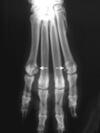Musculoskeletal Flashcards
What are the fibrillar collagens?
Major 1,2,3
Minior 5,11,24,27
major component of macromolecular collagen fibrils
What are fibril-associated collagens with interrupted tuple helices (FACIT)?
9,12,16,19,20,21,22
do not assume fibrillar structure
assocted with fibrilla
important roles in 3D organization and interaction fo fibrillar collagens
Basmentmembrane collagens?
4, 7, 15, 18
Filamentous collagen
6
What is the structure of collagen?
triple helix made of 3 separate polypeptide molecules (alpha chains)
homotypic (same 3 chains) = 2, 3
heteroypic = 5
Describe collagen biosynthesis
transcription of gene and translation mRNA = pre-proalpha chains (pre-pro-collagen)
proline hydroxylation (rate limiting step)
O-linked glycoslation reactions
triple helicies stablized by disulfide bonds
folding = molecular chaperones, cis-trans isomerization (prolylpeptidyl isomerase) = triple helical procollagen
globular teloprptide somains cleaved metalloproteinases = trocollagen
fibrillogenesis (trocollagen +ECM) = fibrils = fascicles = macroscopic fibers
Descrine the structure of a proteoglycan.
Glucosaminoglycan = heparin sulfate, keratan sulfate, D-glucosamine
Galatosaminoglycans = chondroitin sulfate, dermatuan sulfate, D-galactosamine
Hyaluronic acid = nonsulfonated glucosaminoglycan, repeating unitsD-glucuronic acid and D-glucosamine
Diagram of the basic structure of an aggregating proteoglycan. Proteoglycan monomers consist of a core protein with numerous covalently linked glycosaminoglycans. Keratan sulfate and chondroitin sulfate, the most common glycosaminoglycans in articular cartilage, are depicted. In a typical aggregating proteoglycan, hundreds of proteoglycan monomers may associate with a single hyaluronic acid backbone. This association is noncovalent and is stabilized by link proteins. The positions of the globular domains (G1, G2, and G3) of the core protein relative to the glycosaminoglycan binding region are shown. G1 contains a hyaluronan binding domain, and G3 contains domains that bind a variety of extracellular matrix components. The function of G2 is unknown

What are matrix metalloproteinases
Zinc dependent endoprptidases that cleave ECM protieins (collagenaes, gelatinases, stromolysins)
What is elastin?
protein biopolymer = monomeric component is protein tropoelastin (65-70kDa)
formation requires fibrillin microfibrils and fibronectin as scaffold for tropoelastin
elastic deformation or strain of approx 70% restin length, maximum extension of 220% before loss of strength
How does the modulus of elasticity compare between type 1 collagen and elastin?
300-600 kPa elastin compated with 10^6 kPa for type collagen
Sturcture of bone - cortical.
Haversian units
Volkman’s canal

What makes up periosteal ECM?
Type 1 collagen, proteoglycans and elastin
What orchestrates osteoclastic recruitment?
monocyte colony stimulating factor (M-CSF) and receptor activator of NFkB ligand (RANKL)
expressed by osteoblasts, decreases expression of osteoprotegerin (blocks RANKL and prevents differentiation of osteclast precusors)
What is sclerostin?
Released from osteocytes - exerts inhibitory effects on proliferation and biosynthetic activity of osetoblasts
What is another name for a resorption pit?
Howship’s lacuna
What is the mineral composition of bone?
70% mineral, resists compressive force
calcium hydrocyl-apatite
What is the organic matrix of bone composed of?
90% collagen (primarily type 1, also 5 and 3)
What law describes bones ability to remodel in response to mechanical load?
Wolff’s Law 1892
What is the make up of articular cartilage?
70% water
Dry weight = 50% collagen (85-90% type 2- provides tensile stiffnes and strength)
- 35% proteoglycan
- 10% gylcoprotien
minerals and lipis
- 2-10% chondrocytes
Other components: firoenectins, type 11 (stablizes lateral gowth fibrils), Aggrecan (240kDa, major proteglycgan, 90% carbohydrate), leuine rich proteoglycans (chondroitin/dermatan sulfate- decorin, biglycan and keratin sulfate - fibromodulin) modulate fibrillogensis
What are the zones of cartilage?
1: superfical/tangential zone - fibrils tangential (tension)
2: transitional zone - fibrils parallel and branching (shear and compression)
3. radiate zone - fibrils perpendicular (compression)
tidemark
- calcified cartilage zone
conc proteoglycan increase with depth from surface
collagen fibrils more concentrated at surface

How much does osmotic pressure contribute to compresive stiffness of cartilage?
50%
GAGs account for 75% of the osmotic pressure of PGs
What kind of collagen makes up fibrocartilage?
Type 1
Small amounts of proteoglycans
makes up annulus fibrosus, menisci and parapartellar isetions of quadriceps mm.
What are types of tendons?
Aponeuroses
Positional tendons - DDFT
Energy storing tendongs = calcaneal tendon - greater elastic fiber component
Stress-strain relationship of tendons.
intial pahse - straighten fibrils
linear elastic region
rapid loaging = fibrillar elongation and stress relaxation and creep = interfibrillar shear
yeild point
larger diameter = greater stiffness
small diameter - greater surface area and viscoelastic properites
healed collagen fibrils remain smaller and more uniform = inferior properties




























































































































































































